
19 minute read
Traditional Tenkara Kebari Patterns
ISHIGAKI KEBARI
Hook: Barbless dry fly hook in sizes 14 -18 Thread: Black sewing thread Hackle: Brown partridge hackle tied 1/3 down from the eye of the hook – tied with hackle forward to the eye Body: Build up a slim layer of black sewing thread with a slight rise progression to the front of the hook.
Advertisement
Notes (Dirks): The Ishigaki Kebari originated by Dr. Hisao Ishigaki of Japan. With the black sewing thread, tie a tapered body with only a very slight taper to the eye of the fly. You can use a plain brown partridge hackle or other variations of bird that have some speckles (speckled hen) in them. I like to tie this pattern using both brown, mottled brown and grizzly hackle. The sakasa kebari is the iconic tenkara fly pattern. This is the classic reverse hackle tenkara fly and a favorite among many tenkara anglers. Like most tenkara patterns, this fly can be fished dry or wet and is generally the easiest of patterns to tie as well.
Expert Insight: Chris Stewart
“The Ishigaki Kebari is a bit of a hybrid. It is a sakasa kebari, in that the hackle slants forward slightly. However, it is tied with rooster hackle. I doubt the hackle pulses much in the water, but it does effectively resist the pull of the line. Plus, it is a dead simple fly to tie, needing only black thread and brown hackle. When tying it, and all other sakasa kebari, please keep in mind that the forward slant is very slight. I see photos of sakasa kebari that Westerners have tied showing the hackle with an extreme forward slant. Don’t do it. Tying it that way dramatically reduces its effectiveness. It won’t pulse open and it won’t provide much resistance. If tying a sakasa kebari with a soft hackle such as hen pheasant or partridge, the natural cup shape of the feather provides all the forward slant you need, don’t force a more extreme slant with thread wraps.”
TAKYAMA SAKASA KEBARI
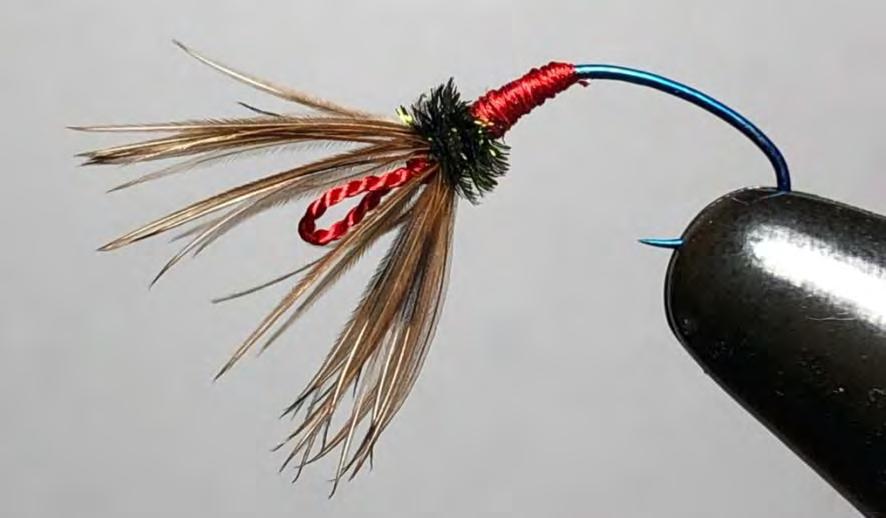
Hook: Gamataksu Amago hook, size 7.5 or Orvis Tactical Czech Nymph hook or Daiichi 1150 or 1160 – sizes 12, 14. Shown in photo: Eyeless Owner hook. Body: Silk thread of your choice, red, black, or primrose yellow Hackle: Partridge feather – from breast or you can use hen pheasant; then a few wraps of peacock herl.
Notes: My favorite and one that I will choose more than 90 percent of the time when selecting a fly is my take on the Takyama Sakasa Kebari. I tie it with red or black (more often red) silk thread, pheasant hackle and a few wraps of peacock herl. I tie it on a size 3 or 4 (Japanese sizing) owner mainstream tenkara hook. This hook is very light slowing the fly to float for a dead drift dry presentation or to be sunk below the surface to present it as a wet fly as it traditionally would be. I find that it is an extremely effective fly everywhere I have had the chance to use it. I also fish with a few variations of some of the traditional tenkara dry flies from time to time. Who does not like to watch a fish slam a dry fly?
Expert Insights: Chris Stewart
“The sakasa kebari’s forward slanting hackle was said to open wider as a tenkara angler gently pulsed the fly, returning to its original shape
between pulses. That would give the impression of life, which is completely absent in a dead-drifting fly. Try to picture a jellyfish swimming in reverse (which it can’t do, but you can reverse a video of a swimming jellyfish). That is what a pulsing sakasa kebari hackle looks like. It doesn’t look like anything that lives in a trout stream, but it does look alive. That made sense, but for years I resisted pulsing my flies. Even though the Killer Bug represents a scud, and scuds can swim, so pulsing would actually make sense, many times when a trout took a Killer Bug the take was so subtle that if my line was bouncing around from pulsing, I wouldn’t be able to tell if the bounce was me or if the bounce was a take. At least, that was what I thought at the time. It took being roundly out fished by a good friend of mine on the Neversink River to make me reconsider. By lunchtime, I’d been skunked, and he’d caught a number of nice fish. I asked him his secret. He’d been pulsing a sakasa kebari, I’d been dead drifting a Killer Bug. After lunch I switched flies and tactics, and immediately started catching fish.
Over the next few years, I gradually came to the conclusion that the sakasa kebari had another benefit, which to my mind greatly overshadowed the pulsing hackle. Rather than a jellyfish doing the backstroke, picture a parachute underwater, resisting the pull on the line. That resistance to being pulled through the water allows you to keep your line a little tighter, and a tighter line is easier to keep off the surface.”
SAKAKIBARA KEBARI (AKA KEEPER KEBARI)
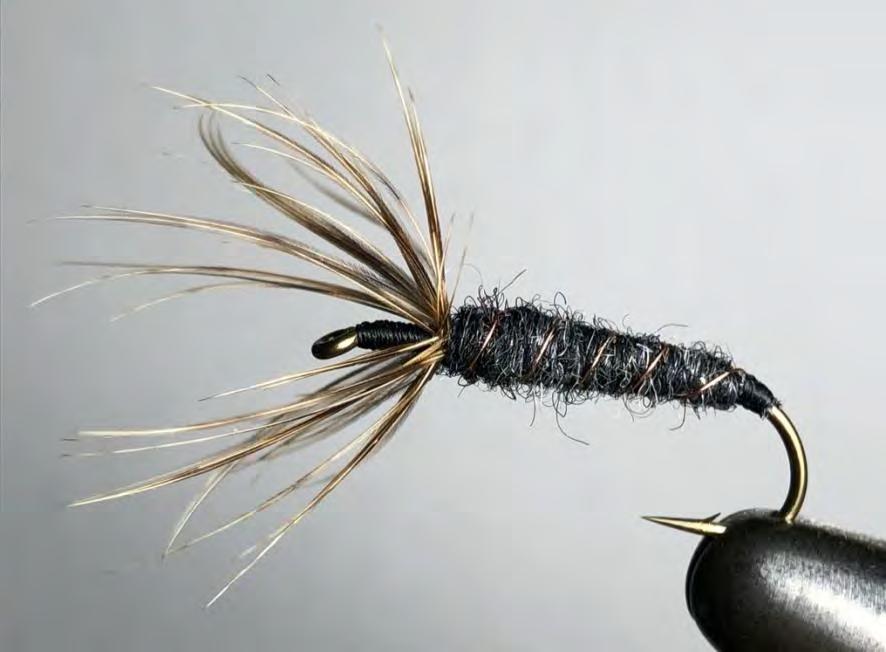
Hook: Daiichi 1560 #6 or equivalent Thread: Black 6/0 Hackle: Pheasant hen feather – from the back
Body: Jamieson’s Shetland Spindrift wool yarn or Black Killer Bugger yarn or equivalent
Notes (Dirks): This is one of the larger of the tenkara kebari trout patterns and is a favorite of many tenkara anglers. This recipe is from Chris Stewart (https://www.tenkarabum.com/) and this pattern is also featured in the excellent video “Tying Tenkara Flies Volume 1.” As Chris notes from his website: “ I like this pattern especially on larger streams but also on days when the water is slightly off color. Just something about a big, juicy fly pattern fished in the minimalist tenkara fashion that can turn on the bite.
OKI KEBARI
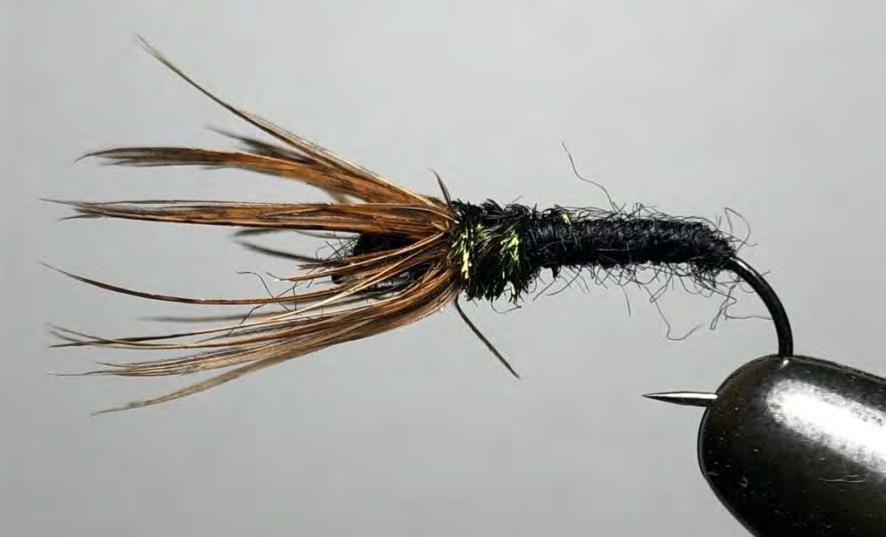
Hook: Sizes 8-12, barbless dry fly hook Thread: Black sewing thread Body: Black sewing thread, peacock herl Hackle: Mottle hen or partridge tied reverse hackle style
Notes (Dirks): Build up the body with the black sewing thread with a slim but slight taper to it. Dan Galhardo, who rightly gets credited for introducing tenkara into the U.S. in 2009, only offers a few basic but highly effective kebari patterns and this is one of them.
AMANO KEBARI

Hook: Orvis 1877 or equivalent in sizes 12, 14 and 16 Thread: Cream 6/0 Body: Cream 6/0 thread Hackle: Mottled brown hackle – partridge works fine
Notes (Dirks): Taper the body slightly with the cream 6/0 thread. Hackle is tied about 2/3 up from the bend of the hook. Fill the space between the hackle and the hook eye with built up cream thread. Traditional Japanese kebari tyers prefer to use silk thread but you can substitute with no harm done.
BLACK SAKASA GUJO KEBARI
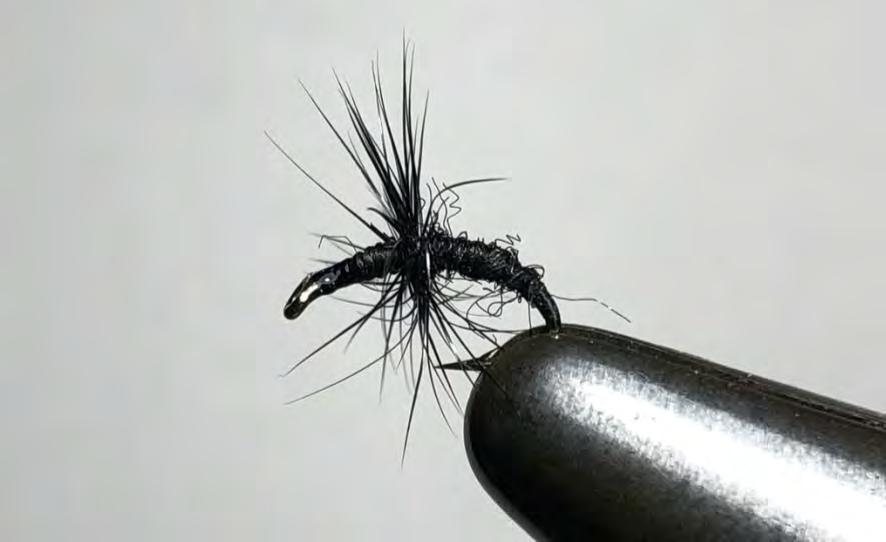
Hook: Orvis 1639 or equivalent in sizes 12, 14 and 16 Thread: Black 6/0 Body: Black rabbit dubbing – natural or Orvis Spectrablend Hackle: Brown
Notes (Dirks): For the body, make sure it’s a relatively level body when dubbing. Another effective variation of this fly is to use tightly wrapped round ribbing material (medium) for the body instead of the black fur.
AKIYAMAGO HAYASHI KEBARI

Hook: Owner Main Stream, size 3 or Gamakatsu C13U or equivalent in sizes 12,14, 16 Thread: Black, green, olive or red thread- 6/0 Body: Black, green or red thread - 6/0 thread, one strand of peacock herl tied in at the abdomen just before the hackle Hackle: Black
Notes (Dirks): As a dry fly, this could be tied in several other colors including tan, olive and brown. I tied this using an Orvis tactical barbless hook in size 14 – which is a Czech nymphing hook.
YAMAGATA SENDAI KEBARI

Hook: Orvis 1639 or equivalent in sizes 12, 14 and 16 Thread: Black 6/0 Body: Black rabbit or Orvis Black Spectrablen Hackle: Grizzly Antennae: Single strands of pheasant tail Tail: Single strands of pheasant tail
Notes (Dirks): I believe this recipe is true to traditional tenkara kebari standards, but the variations are many in the context of colors. While traditional tenkara emphasizes less on variety of patterns and more on varying size and fly manipulation, for those of you inclined for a bit more variety – it’s hard if not completely impossible to go cold turkey from dozens of patterns in the box to just a few.
FUJIOKA KEBARI
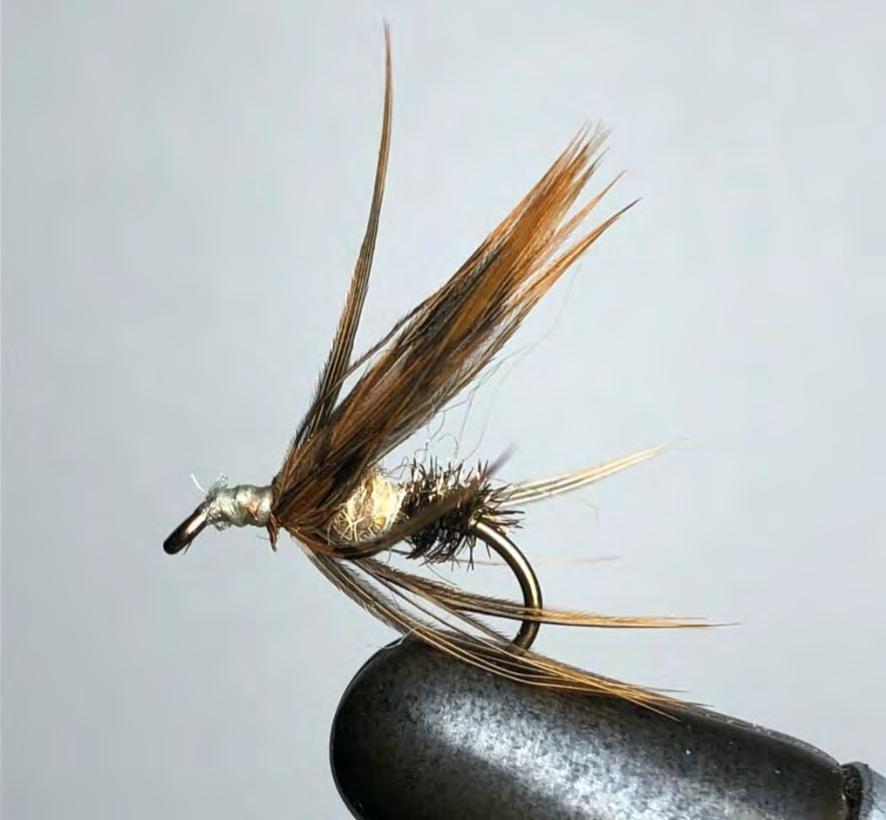
Hook: Orvis 1639 or equivalent hook sizes 12, 14, 16 Thread: Tan 6/0 Body: Tan Rabbit dubbing or Orvis Tan Spectrablend Hackle: Brown
Notes (Dirks): This fly is accredited to Yoshikazu Fujioka. This fly –and the color variations that can be made from it – is much like the Western soft-hackled fly to the point where I don’t really see much difference. As a soft hackle wet fly pattern, it is deadly when used with the tenkara method of fly-fishing.
KUROBE KEBARI
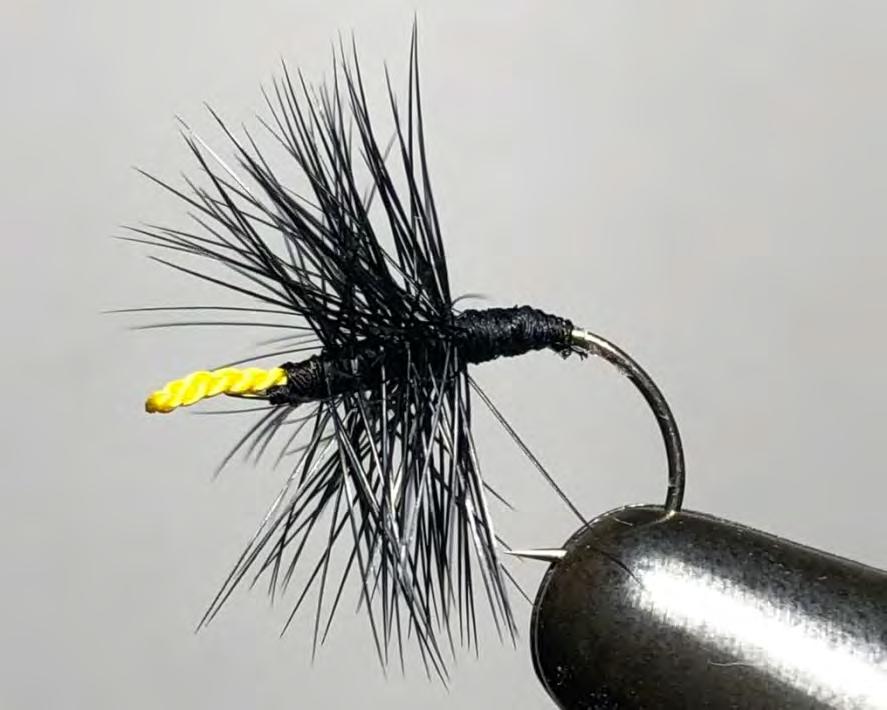
Hook: Owner Keiryu Hook, size 8 or Orvis Tactical Czech Nymph hook, size 10, 12, 14
Thread: Pearsall’s Gossamer Silk Thread, color black Hackle: Whiting Dry Fly Hackle, size 12, color black
Notes: Traditional Kebari recipe calls for an “Owner hook”, which is eyeless. Natural silk bead cord, size 2 and yellow, was used to make the eye.
KYOTO KEBARI
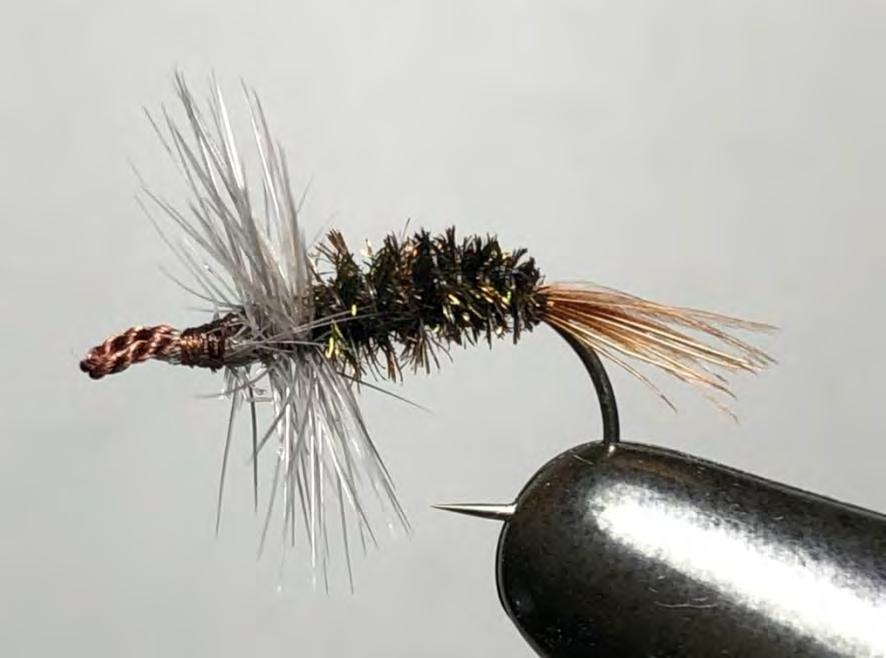
Hook: Owner Keiryu Hook, size 8 or Orvis Tactical Czech Nymph hook, sizes 10, 12
Thread: Pearsall’s Gossamer Silk Thread, color brown Hackle: Whiting Dry Fly Hackle, size 12, color dun Body: Peacock herl Tail: brown hackle fibers
Notes: Owner hook is eyeless. Natural silk bead cord, size 2 and brown, was used to make the eye.
OKUSHINANO AKIYAMAGO KEBARI
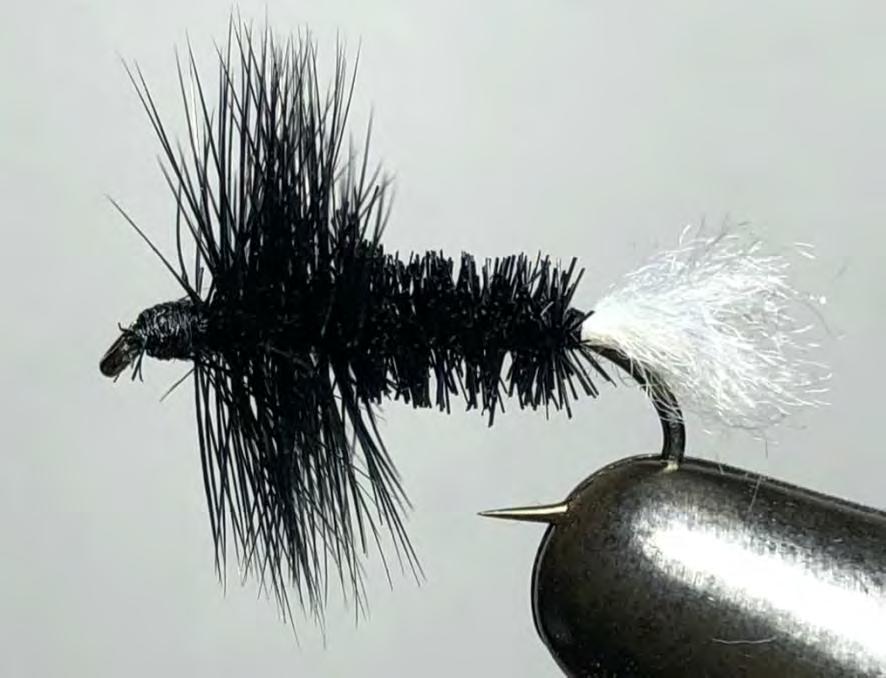
Hook: Orvis Nymph Hook No. 1524, size 12 Thread: Pearsall’s Gossamer Silk Thread, color black Hackle: Whiting Dry Fly Hackle, size 12, color black. Tied along the entire shank of the hook. Body: Same as above except that the posterior 2/3 of the hackle has been trimmed to form the body. Tail: Small piece of white yarn
Notes: The Okushinano floats really well and I also like to tie this pattern in brown and olive with same white tail from yarn.
HIDA SHOKAWA KEBARI

Hook: Mustad C49S scud hook, size 10
Thread: Pearsall’s Gossamer Silk Thread, color black Hackle: Hen Pheasant
Body: Peacock Herl Tag: Green mylar tinsel
Notes (Dirks): One of my favorite Kebari patterns that catches trout consistently – especially when not much is happening on the surface. One of those patterns looks like nothing but looks like everything tasty to a trout. The hackle undulates in the water well and a slight twitch as it travels through the current often creates an opportunity for a take. Reminds of the western Leadwing Coachman.
AWA NAKAGAWA KEBARI
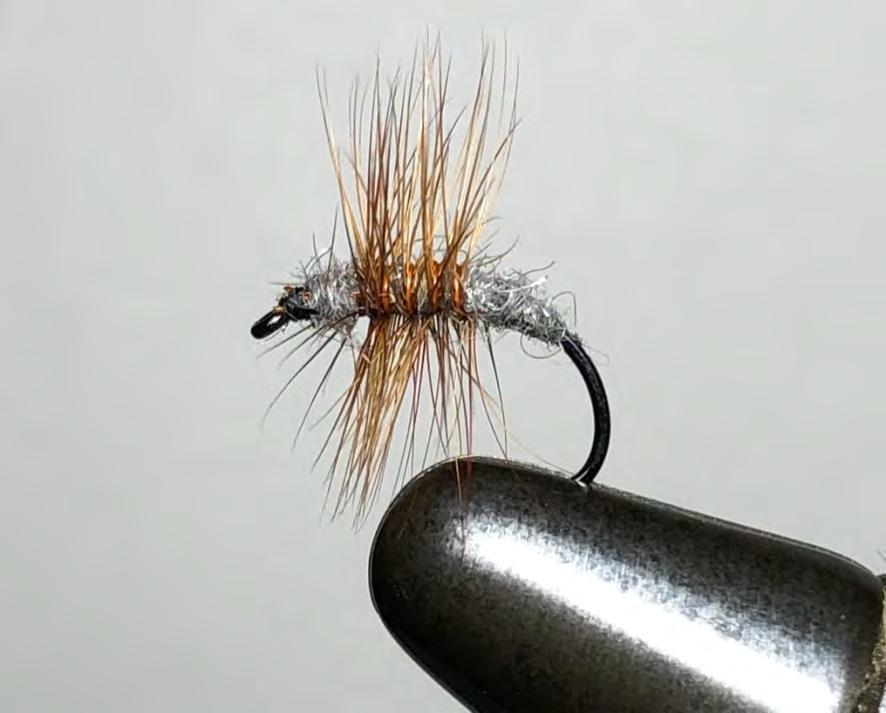
Hook: Orvis Tactical Czech Nymph hook, size 12, 14 Thread: Black Uni-thread 6/0 Hackle: Brown hen hackle Tail: Spectrablend Nymph, Grey
Notes (Dirks): This kebari pattern is tied as in photo with full hackle wrap and can also be tied with the hackle on the underside of the kebari cut. Either way, a highly effective kebari pattern that represents a lot of different insects in most parts of any season. I’ve found it especially effective in May and June time frames on the east coast and June and July in western USA streams.
OZE KEBARI

Hook: Mustad C49S scud hook, size 10
Thread: Pearsall’s Gossamer Silk Thread, color black Hackle: Whiting Dry Fly Hackle, size 12, color white.
Notes (Dirks): Some inspired variations of this pattern that are also effective: Brown hackle w/ olive thread; Grey hackle with grizzly or badger hackle. Simple to tie and fish in the spirit of Tenkara!
OKUSHINANO ZAKOGAWA KEBARI

Hook: Owner Yamame Hook, size 7 or Orvis Tactical Czech Nymph hook, size 10, 12
Thread: Pearsall’s Gossamer Silk Thread, color classic chestnut Hackle: Whiting Dry Fly Hackle, size 12, color white. Rib: Peacock Herl
Notes: Owner hook is eyeless. Natural silk bead cord, size 2 and white, was used to make the eye.
ASAHI KEBARI

Hook: Mustad Streamer hook, size 12
Thread: Pearsall’s Gossamer Silk Thread, color black Wing: Pheasant tail feather fibers Body: Shetland’s sprindrift wool yarn, color sand Rib: Peacock Herl
Notes (Dirks): Small but effective streamer that I like to use in fast water pocket fishing in particular. I prefer to impart a bit of movement on this pattern as it sweeps through pocket water and riffles although a dead-drift also works well.
OKUSHINANO UNOGAWA KEBARI

Hook: Mustad Nymph Hook #S80-3906, size 10 Thread: Pearsall’s Gossamer Silk Thread, color black Hackle/Wing: Eurasian Jay Body: Peacock Herl
Notes: Chris Kuhlow gets the credit for tying this beautiful kebari pattern. While I have not yet fished the Okushinano, my fishing guess is that it would have every chance of testing appetite of any trout on the right day. Think of it in terms of one of those patterns that is not an imitation as much as it represents something edible to the fish.
NIKKO KEBARI
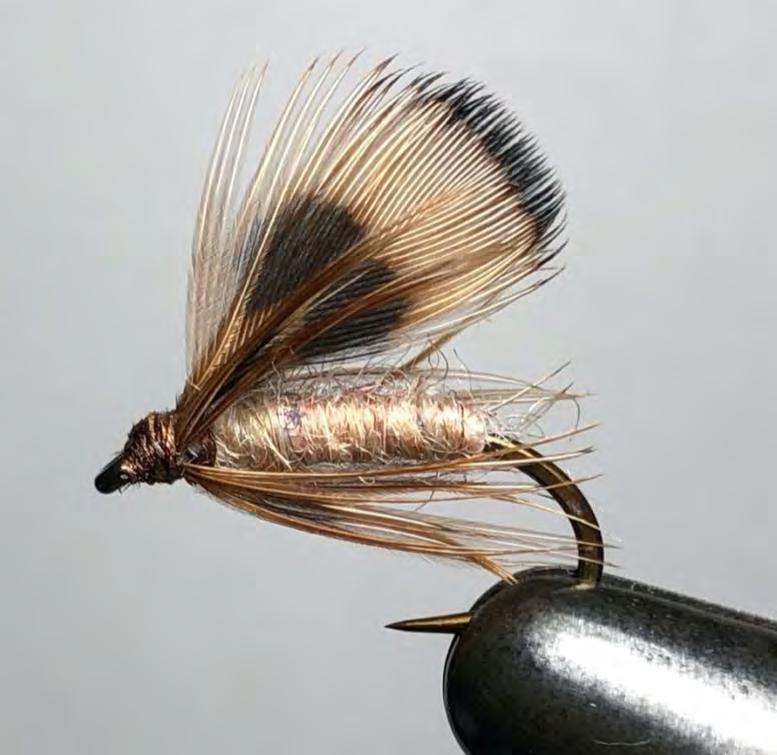
Hook: Mustad Nymph Hook #S80-3906, size 10 Thread: Pearsall’s Gossamer Silk Thread, color brown Hackle/Wing: Hen Pheasant Body: Shetland’s Spindrift Wool Yarn, color sand…further colored with Prismacolor marker, color sand (this is similar to how Chris Stewart ties his Killer Bug.)
Notes (Dirks): I also like this on a longer streamer hook as well – fishes very well. For some Kebari-inspiration you can also tie this in different body that are a bit darker shades from sand right up to brown. While dead-drifting this pattern through seams and pools is very effective, I often will impart some action into this fly when dead-drifting doesn’t bring strikes.
KOSHU KUROMORI KEBARI
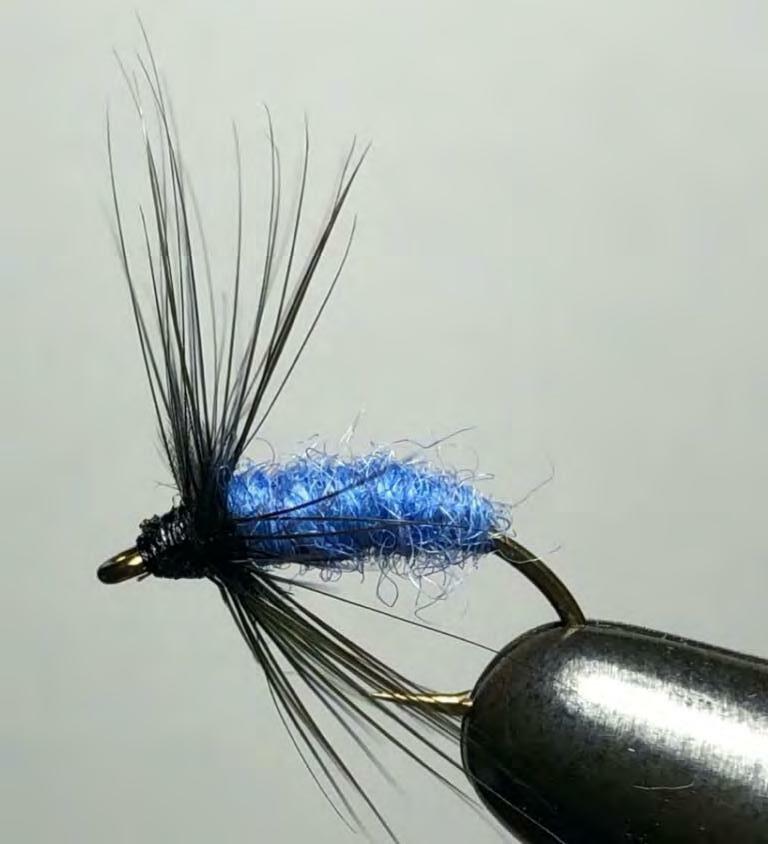
Hook: Mustad C49S scud hook, size 10
Thread: Pearsall’s Gossamer Silk Thread, color black Hackle: Whiting Hen Saddle Hackle, color black Body: Shetland’s Spindrift Wool Yarn, color blue (obtained from Chris Stewart)
Notes (Dirks): On first pass, this blue bodied fly would not necessarily attract a western-style fly angler who is used to naturally colored patterns to imitate what’s in the water. However, this is one of those “changeup” patterns to try when nothing else seems to be working. I also like to tie this pattern with a purple body.
OKUMIKAWA KEBARI

Hook: Mustad C49S Scud Hook, size 10
Thread: Pearsall’s Gossamer Silk Thread, color lemon yellow Hackle: Hen Pheasant
Rib: Peacock Herl
Tail: Peacock Herl
Notes (Kuhlow): The peacock herl used in this fly is wound down the shank of the hook, almost like a rib. I left a little extra herl hanging off the end of the hook and tied it off to create the tail. I also used a #10 C49S for convenience.
OKUYOSHINO TOTSUKAWA KEBARI
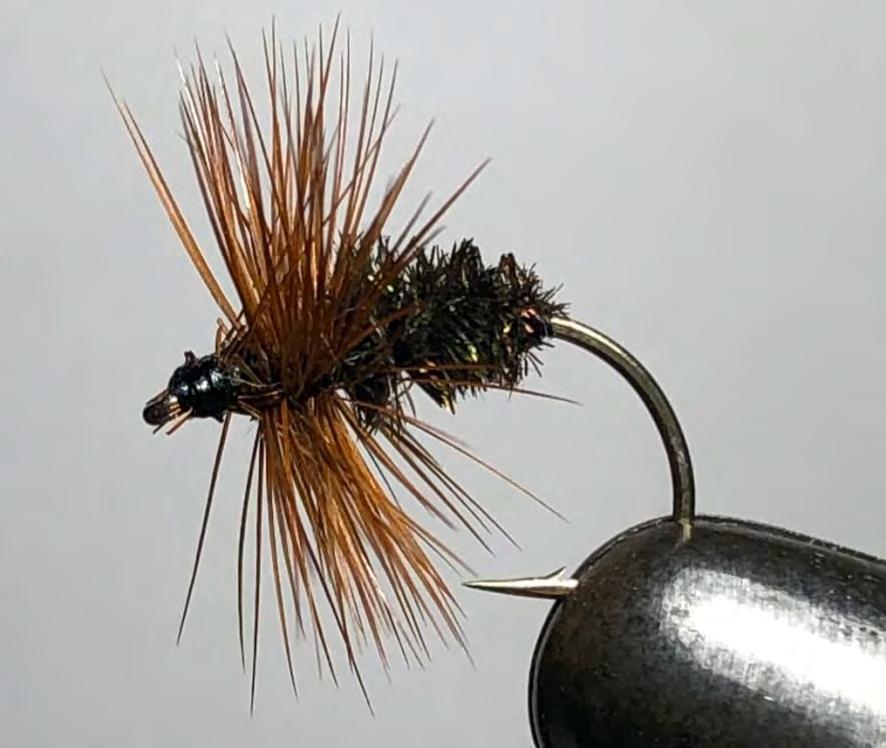
Hook: Owner Mainstream Tenkara Hook, size 4
Thread: Pearsall’s Gossamer Silk Thread, color black Hackle: Whiting Dry Fly Hackle, size 12, color brown. Body: Peacock Herl
Notes (Dirks): Another Leadwing Coachmen look-alike but effective as such in catching trout.
JOSHU TSUMAGOI
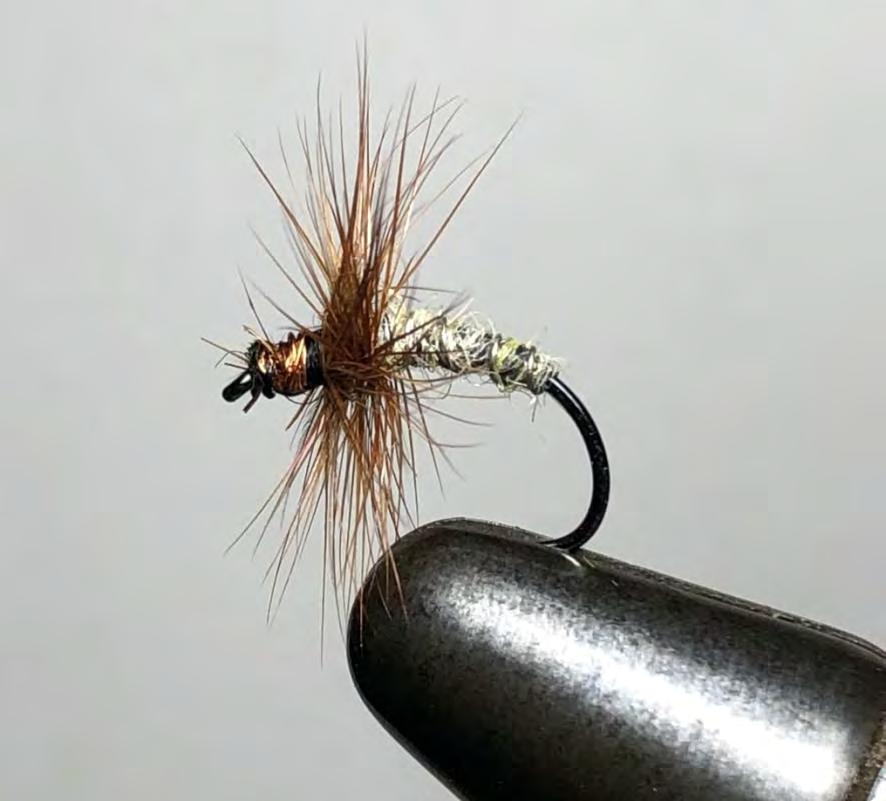
Hook: Mustad R7-7957 Nymph or Orvis Tactical Czech Nymph hook, size 12, 14 Thread: Copper wire, brassie Hackle: Soft hackled hen saddle, brown Body: Peacock Herl with copper wire rib
Notes (Kuhlow): The bodies of these flies have been tied with peacock herl or yellow embroidery thread. I tied this one with a Mustad nymph hook (size 12) and used copper wire (brassie) to tie the whole fly (similar to what I would do when tying a Killer Bug).
HIDA TAKAYAMA

Hook: Gamakatsu eyeless, size 7.5 or Tiemco 206BL Thread: Pearsall’s gossamer silk, red Hackle: Hen Pheasant
Body: Pearsall’s gossamer silk, red Collar: Peacock Herl
MINO GUJO
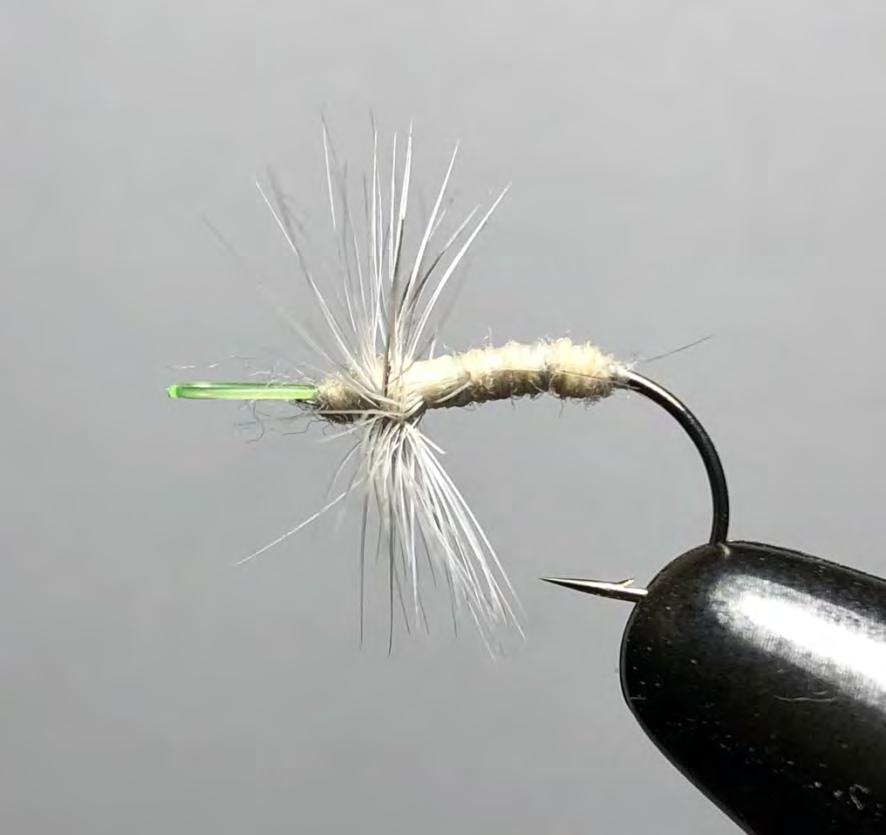
Hook: Owner eyeless, size 8 Orvis Tactical Czech Nymph hook, size 12, 14 Thread: Uni-Yarn, 2x regular, cream Hackle: Cream saddle hackle
Body: Uni-Yarn, 2x regular, cream
Notes (Dirks): I have also found this pattern effective when tied in brown, black, and grey with matching hackle & body color.
AJARI’S DARK KEBARI
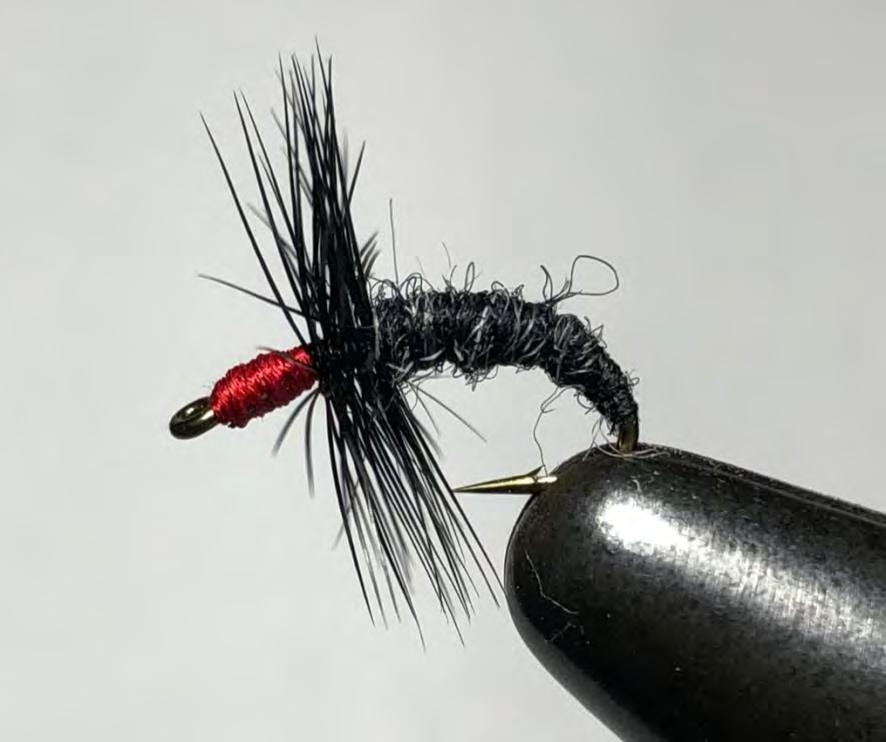
Hook: Mustad C49S, size 12
Thread: Uni-Thread, Black and Pearsall’s Gossmer silk, red for the head Hackle: Black saddle hackle
Body: Jamison’s Shetland Spindrift wool, Oxford
Notes (Dirks): Like any pattern in this book, feel free to substitute materials as necessary – not everyone has Jamison’s Shetland Sprindrift wool hanging around. I prefer a bugger black body on most of my patterns but that’s a personal preference.
AJARI’S LIGHT KEBARI
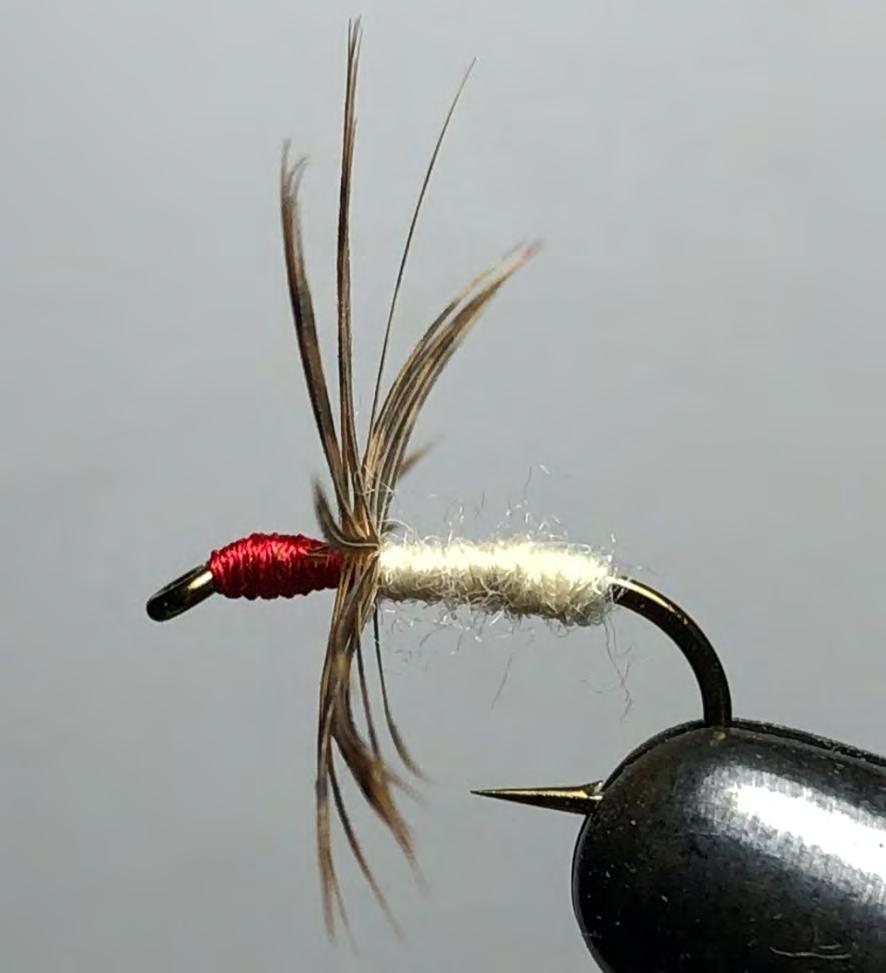
Hook: Mustad R70-7957 nymph, size 12 Thread: Pearsall’s Gossamer silk, Red Hackle: Soft Hackle Hen saddle, brown Body: Uni-Yarn 2x regular, cream
SAKASA KEBARI

Hook: Mustad C49S, size 12 Thread: Uni-Thread, black Hackle: Soft Hackled Hen saddle, brown Body: Uni-Thread, black
Notes (Dirks): Classic tenkara kebari pattern – simple and deadly in its ability to catch fish consistently. I will start by dead-drifting and then imparting a slight bit of movement if the dead-drift doesn’t do the trick. I also find this effective in sizes 14 and 16 as well.
BLACK AND SILVER LOOP-EYE SAKASA KEBARI
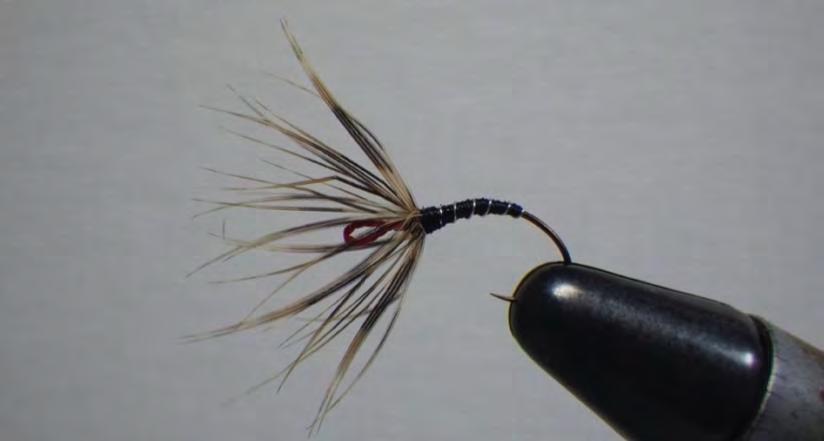
Hook: Size 7 Owner Super Yamame eyeless hooks – sizes are different from Western convention. I’d say it is similar in size to a size 10 hook or so. The only place I know to get them is www.tenkarabum.com. Hook “eye”: No. 2 Red Griffin Perlseide Silk Bead Cord. This can be tough to find locally. Some specialty bead shops have it but I haven’t found any locally, but a search on Google will turn up some. Thread: 8/0 Black Hackle: Hen ringneck pheasant. Tie the feather in by the tip. Body: Black thread. Rib: Fine silver wire. Notes (Naples): Some tenkara anglers in Japan use eyeless hooks for their flies so I’ve been trying these too. This pattern is based on a silver ribbed black thread midge pattern. It’s pretty basic and I know other tenkara anglers in the U.S. have tied very similar flies – I certainly wouldn’t make any proprietary claim to this style of fly. You could tie it in many combinations of thread and ribbing color, but I have always had good luck with black and silver. I chose red for the loop-eye just because I thought it might act as a bit of an attractor for the trout. I don’t have a good name for it, so it’s just the “black and silver loop-eye sakasa kebari.” The Owner Super Yamame hooks are thin wire hooks and seem to be extremely sharp. Loop-eye flies are also nice because the eye can be made pretty big for those of us that are getting older and have a hard
time seeing those tiny hook eyes.
JOSHU TSUMAGOI KEBARI
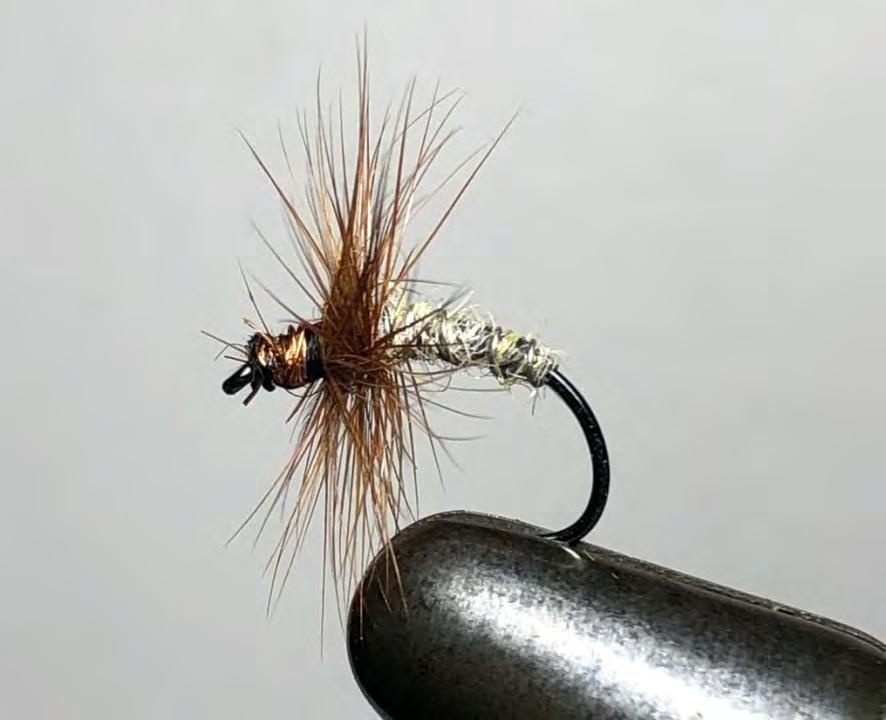
Hook: Orvis Tactical Czech Nymph hook, size 14 Thread: Black or brown 6/0 Hackle: Brown hen hackle Body: Spectrablend, cream or similar substitute; Rib: X-small silver wire woven over the cream body to the hackle.
Notes (Dirks): Finish off the head with x-small copper wire.
SANADA KEBARI

Hook: Orvis Curved Nymph Hook – 1510, size 14, 3x Thread: Black 6/0 Hackle: Brown hen back Body: Spectrablend, Nymph, Tan or equivalent; for abdomen – Orvis Spectrablend Caddis, caddis green – follows the tan body but before the brown hen is tied in near the head Rib: Red floss – wrapped on the tan body only
NAKASHINANO SHIOJIRI KEBARI
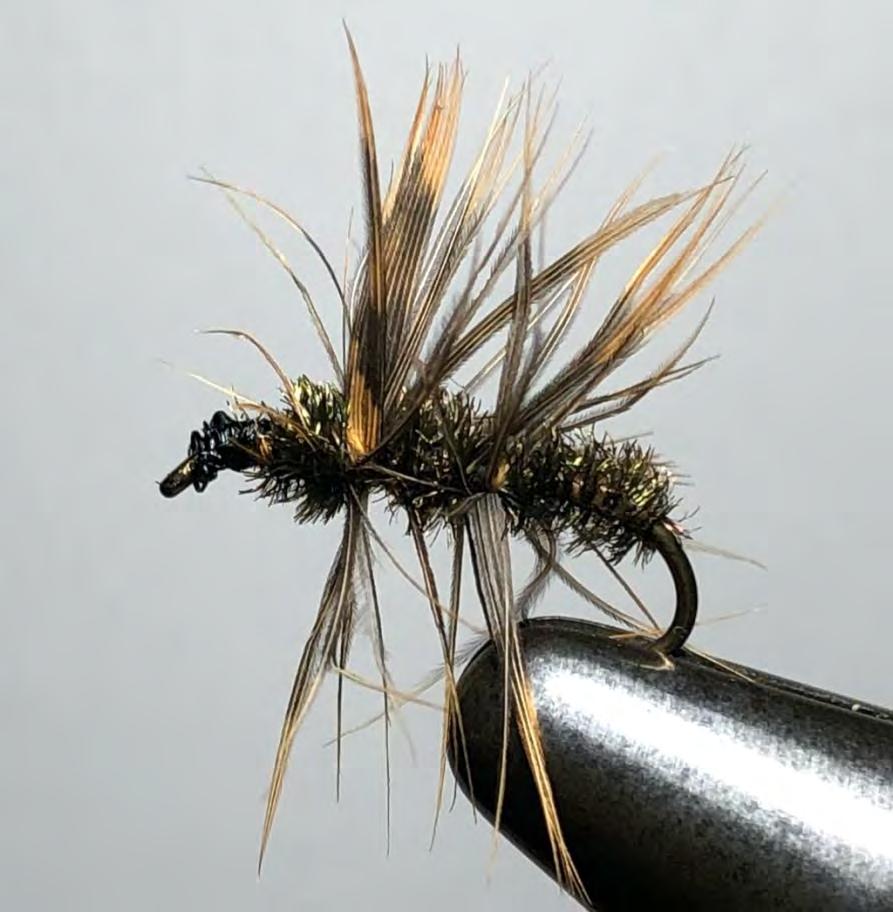
Hook: Mustad 3906B, size 10 or equivalent Thread: Black 6/0 Hackle: Brown hen back or brown hen hackle
Body: Peacock herl
Notes (Dirks): I prefer brown hen back for the webby, buggier look than what the traditional pattern might call for. The two hackles on this kebari provides a buggy, undulating opportunity for trout to consider. I use this when no hatches appear and the action below the surface is slow.
BANSHU KEBARI
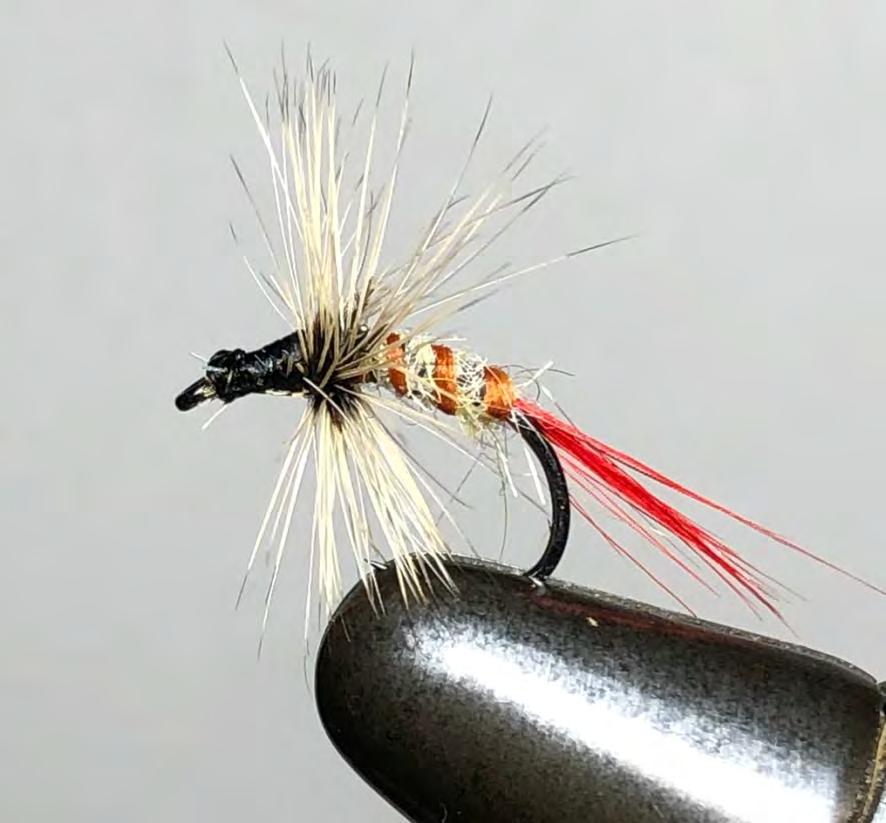
Hook: Orvis Tactical Czech Nymph hook, size 14 Thread: Black or brown 6/0 Hackle: Badger hen hackle Body: Spectrablend Nymph, Cream; Brown Uni-floss for ribbing Tail: Red hackle
Notes: If you lighten to a dry fly hook - like a Daiichi 1110 or 1180 –this is effective as a dry fly too.
SHOKAWA KEBARI
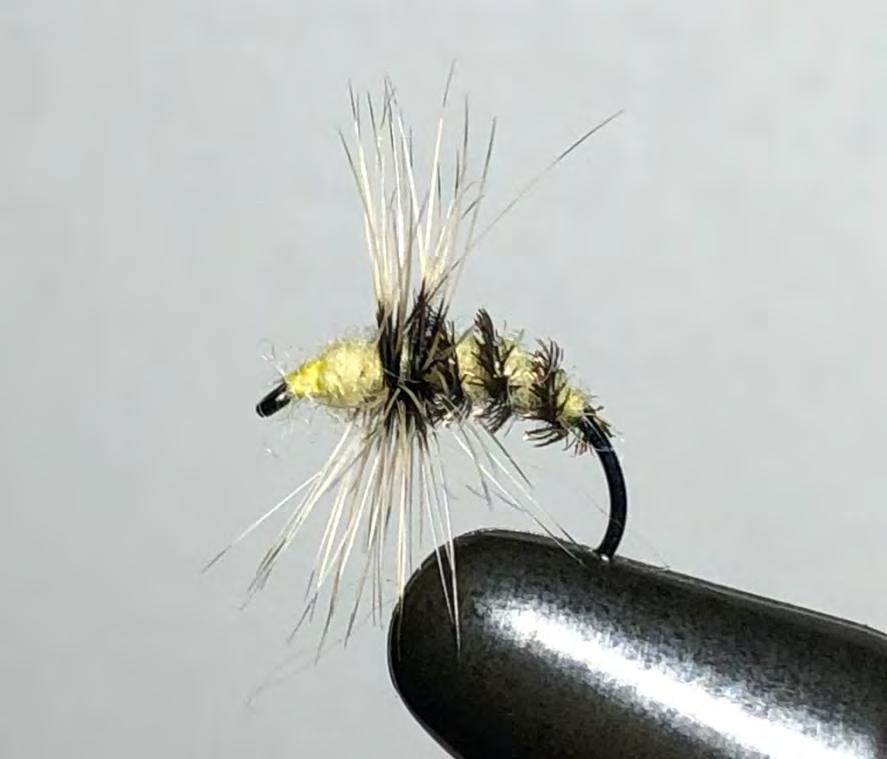
Hook: Orvis Tactical Czech Nymph hook, size 14, 16 Thread: Yellow Uni-thread 6/0 Hackle: Badger hen hackle Body: One strand of peacock herl; Hareline Micro Fine Dry Fly Dub –Sulfur Yellow
Notes (Dirks): Another one of those patterns that doesn’t specifically represent one insect but provides coverage for all kinds of buggy looking trout morsels. I keep these stocked in my kebari box in both sizes 14 and 16 and I recommend you do the same.
SHOWKAWA KEBARI – RED

Hook: Orvis Tactical Czech Nymph hook, size 14 Thread: Uni-thread Red, 6/0 Hackle: White or cream hen hackle Body: Uni-Thread Red, 6/0
Notes (Dirks): I like to tie this kebari pattern with a slightly larger hackle than you would normally size for a size 14 hook. There’s a lot of speculation about flies that have red tied into them – often at the head or butt section of various fly patterns. While I cannot scientifically point to anything that validates the effectiveness (or lack of) of tying in red in any fly pattern – I still like it as an option in my box. This simple pattern has red covered on all bases and I have found it to be effective when nothing else subsurface seems to trigger a response from trout.







